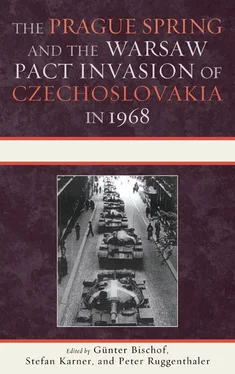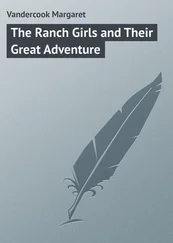14. The idea of turning points in the Cold War is explicated in the volume by Kiron K. Skinner, ed., Turning Points in Ending the Cold War (Stanford, CA: Hoover Institution Press, 2008).
15. Matthew J. Ouimet, The Rise and Fall of the Brezhnev Doctrine in Soviet Foreign Policy (Chapel Hill: University of North Carolina Press, 2003).
16. See the chapter by Alessandro Brogi in this volume.
17. A good summary of some of these factors is Gerhard Wettig, “Längerfristige Folgewirkungen des Reformkommunismus und der Militärintervention in der ČSSR im Jahr 1968,” HISTORICUM (Winter 2007/2008–Spring 2008): 69–76; see also the chapter by Mark Kramer in this volume.
18. For details see above all Jan Pauer, Prag 1968: Der Einmarsch des Warschauer Paktes: Hintergründe—Planung—Durchführung (Bremen: Edition Temmen, 1995), which was for a long time the only work of reference in German to be based on Soviet files.
19. Parts of this introduction are based on the extensive introduction by the same authors to Karner et al., Beiträge , 17–67.
20. See the chapter by Manfried Wilke in this volume. See also appendix 1.
21. For details here and subsequently, if no other references are specifically cited, see Karner, Bischof, Wilke, and Ruggenthaler’s introduction, in Karner et al., Beiträge , 17–67.
22. See Mikhail Prozumenshchikov’s chapter in this volume.
23. See Prozumenshchikov’s chapter in this volume.
24. Iskra Baeva, “Bulgarien—der treue Vasall des Kreml,” in Karner et al., Beiträge , 461–80.
25. Paweł Piotrowski, “Polen und die Intervention,” in Karner et al., Beiträge , 447–60.
26. See the Wilke chapter in this volume.
27. Baeva, “Bulgarien—der treue Vasall des Kreml,” 468.
28. AdBIK, transcript of the conference “Sovetskii Soyuz, Avstriya i mezhdunarodnyi krizis 1968 goda,” Russian State University of the Humanitites, Moscow, 31 May–1 June 2007.
29. Ol’ga Pavlenko, “Der Informationsfluss an die Moskauer Machtzentrale,” in Karner et al., Beiträge , 243–78.
30. See the chapter by Csaba Békés in this volume.
31. SAPMO-BA, DY 30/11834, pp. 1–271, stenographic transcript of the consultations between the five fraternal parties and the KSČ in Dresden, 23 March 1968, in Karner et al., Dokumente , #75.
32. On the fear of counterrevolution and its contagiousness on the regime of fraternal states, see the chapter by Mark Kramer in this volume.
33. See the Wilke chapter in this volume.
34. See the Prozumenshchikov chapter in this volume.
35. Pavlenko, “Der Informationsfluss an die Moskauer Machtzentrale,” 267.
36. RGANI, F. 2, op. 3, d. 95, pp. 3f., 73–87, speech of the general secretary of the CC CPSU, L. I. Brezhnev, “On current problems of the international situation and on the CPSU’s struggle for the unity of the worldwide communist movement,” at the plenum of the CC CPSU, 6 April 1968, reprinted in Karner et al., Dokumente , #31.
37. Pavlenko, “Der Informationsfluss an die Moskauer Machtzentrale,” 273.
38. Gomułka’s meeting with Marshall Yakubovskii on 19 April is cited in Piotrowski, “Polen und die Intervention,” 449; see also Mastny, “Was 1968 a Strategic Watershed in the Cold War?” 156. The Germanophobe Gomułka also urged the Soviets not to deploy any East German troops in such an operation. The maneuvers launched in Czechoslovakia soon thereafter also were supposed not to include forces of the East German Nationale Volksarmee (NVA). Only after Ulbricht’s massive lobbying in Moscow were NVA troops included. Ulbricht also insisted on being part of the military preparations for the invasion and the inclusion of the NVA. Only upon sincere pleading by faithful Czechoslovak Communists in Moscow were East German forces asked not to join the operational forces in the final hours before the invasion. Gomułka tried to trivialize the marginalization of the East Germans before a group of the Polish Central Committee in Warsaw. He argued that the NVA troops were scheduled from the very beginning only to occupy adjoining border areas to the GDR. Gomułka wanted to convince his party colleagues that he had considerable pull in Moscow. The NVA’s exclusion from the invasion operations is covered in Rüdiger Wenzke, “Die National Volksarmee der DDR: Kein Einsatz in Prag,” in Karner et al., Beiträge , 673–86, as well as the Wilke chapter in this volume; Gomulka’s intrigues vis-à-vis the NVA are also covered in Pauer, Prag 68 , 229.
39. RGANI, F. 2, op. 3, d. 94, pp. 1–15, speech of the minister of defense of the USSR, A. A. Grečko, at the plenum of the CC CPSU, 10 April 1968, reprinted in Karner et al., Dokumente , #33. Partly reprinted in this volume as appendix 2.
40. Valerij Vartanov, “Die militärische Niederschlagung des ‘Prager Frühlings,’” in Karner et al., Beiträge , 660–73.
41. Aleksandr Bezborodov, “Sowjetische Hochrüstung als Folge des Einmarsches,” in Karner et al., Beiträge , 701–16.
42. Bezborodov, “Sowjetische Hochrüstung als Folge des Einmarsches,” 716.
43. See the Nikita Petrov chapter in this volume.
44. Pavlenko, “Der Informationsfluss an die Moskauer Machtzentrale,” 271.
45. Pavlenko, “Der Informationsfluss an die Moskauer Machtzentrale,” 271; RGANI, F. 5, op. 60, d. 313, pp. 5–23, report of the CC CPSU head of the Department of Liaison with the Communist and Workers’ Parties of the Socialist Countries, K. Rusakov, on the Socialist countries’ reactions to the events in the ČSSR, 26 April 1968, reprinted in Karner et al., Dokumente , #163.
46. Baeva, “Bulgarien—der treue Vasall des Kreml,” 468.
47. Baeva, “Bulgarien—der treue Vasall des Kreml,” 470.
48. Pauer, Prag 68 , 73; see also the Wilke chapter in this volume.
49. RGANI, F. 10, op. 1, d. 235, p. 27, minutes of the meeting of the leadership of the CC CPSU with the leaders of the Communist parties of Bulgaria, Hungary, the GDR, and Poland, 8 May 1968. The stenographic transcript of the meeting is reprinted in Karner et al., Dokumente , #77.
50. The maneuvers codenamed “Sˇumava” ( Böhmerwald ) “were staged to demonstrate that the Czechoslovak army was not up to its task,” argues Vojtech Mastny who adds, “perhaps the only military exercise in history meant to show that forces taking part in it, were not ready to fight.” See his “Was 1968 a Strategic Watershed in the Cold War?” 158. The pitiful state of the Czechoslovak Army is also part of an early July conversation between Yakubovskii and Dzúr, see SAPMO-BA, DY 30/3618, pp. 80–87, reprinted in Karner et al., Dokumente , #89.
51. Melyn P. Leffler, For the Soul of Mankind: The United States, the Soviet Union and the Cold War (New York: Hill and Wang, 2007), 234–58; for Brezhnev’s intense interest in the success of détente, see also Zubok, Failed Empire , 207–9, 218–22.
52. Karner et al., Dokumente , #89.
53. Karner et al., Dokumente , #89.
54. Baeva, “Bulgarien—der treue Vasall des Kreml,” 471–72.
55. See the Prozumenshchikov chapter in this volume.
56. See Prozumenshchikov’s chapter in this volume; Kramer also stresses the importance of the Hungary 1956 historical analogy for Kremlin decision makers.
57. See the Wilke chapter in this volume.
58. The stenographic transcript of the meeting’s proceedings is reprinted in a German translation in Karner et al., Dokumente , #82. Excerpts in English are reprinted in Navrátil et al., Prague Spring 1968 , 212–33.
Читать дальше












